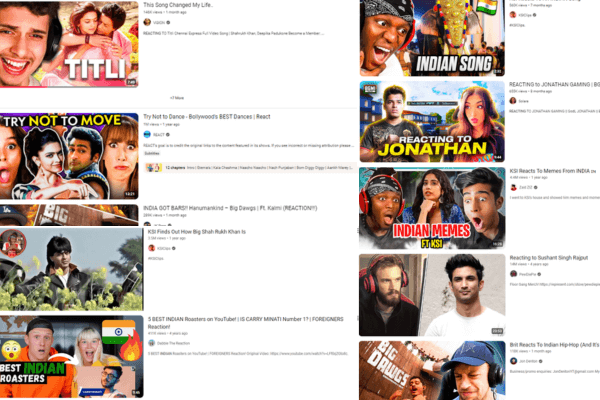Would you watch a movie review by someone who has no experience in the film industry? Would you watch a food review by someone who has no experience making food in any professional or semi-professional capacity? Over the past few years, reaction videos centred around foreigners who have no background in any of the above, reacting to Indian products has risen in popularity.
Type in the words “Indian film reactions” into YouTube and the first suggested option is “Indian film reactions by foreigners.” Scroll down, and you’ll see thumbnails featuring foreigners making exaggerated facial expressions to the point that they seem cartoonish. It’s not rare to see video titles such as “Unexpected Indian Film,” or “Insane Indian Film,” as though it were somehow a surprise that good art can come out of the country.
This genre of videos itself is absurd in which viewers watch YouTubers watch a video. Yet it is a format that continues to be popular. Within this genre is a sub-type of videos in which people react to things such as films, food or the music of another culture. The popularity of these videos can be attributed to the fact that they seem to symbolically have the effect of bridging a cultural divide (in a very minimal sense).

These reaction videos are certainly not rare to come by, with certain channels having amassed more than 2.5M subscribers and which have been operating for more than four years.
On the one hand, the videos can be seen as meaningless fun and as a positive way to exchange culture. It’s fair to assume that many members of the audience are aware of the superficiality of these videos but continue to watch anyway. From a viewer’s perspective, there’s excitement in watching someone who was previously ignorant of a work you love experience it for the first time. You simultaneously feel a thrill of anticipation and have the opportunity to experience the art afresh with a new perspective.
Videos where YouTubers offer their own insightful opinions can have an added educational quality to them. For example, in Our Stupid Reaction’s video on the global hit Big Dawgs, they commented on the similarities between the song and the music they listened to growing up. Unlike other reaction videos, this review gave insight into the artist’s musical influences thus heightening the musical appeal of the song to avid listeners as well.
But too often, reaction videos lack this symbiotic relationship where viewers gain any insights of value. Many YouTubers such as Toma Puck have based their entire careers on reviewing predominantly Indian content, yet you would be hard-pressed to find a video where they give a critical review. The fact that their reactions are consistently positive, gives cause to wonder whether their engagement with the content is genuine or whether they simply want to appeal to their audience.
When I watch their videos, I know exactly when the YouTubers will gasp, when they will laugh and when they will cry. These videos are so predictable that it’s unlikely that their subscribers are watching the video out of a sense of curiosity towards the opinions of these creators, but rather, because it acts as validation that Indian art can be appealing to non-Indians as well.
View this post on Instagram
An example of this is a YouTuber’s reaction to the song Titli from the film Chennai Express, where he was already mind-blown 10 seconds into the song, making comments like “Is this the greatest Indian song I’ve heard? I actually have to stand up because it’s so good!” It’s reactions like these which encourage the audience to respond to the videos with further suggestions in the hopes of rectifying the cultural blind spots of video creators. As a result, these creators get further engagement with their content and ideas for more videos. Their ignorance of Indian culture is what fuels their success. It’s in fact, the viewers who work hard to educate and who subsequently thank YouTubers for paying attention.
The comments section is often replete with statements such as “Bro’s reactions make me feel blessed to be born as Indian.” This begs the question of why this recognition is a prerequisite to feeling blessed.
As we Indians get excited whenever any Indian makes it to the big stage and is recognised by non-Indians, it’s no surprise that these YouTubers have managed to find a faithful audience. The praise of these video creators seem to symbolically indicate an acceptance of Indian culture by the West.
Whilst there will always be an audience for these reaction videos, the good news is that there is now a more evident embrace of the uniquely Indian experience as seen through the global recognition of films such as All That We Imagine as Light. Perhaps with the increased representation of Indian artists at the international level, we will no longer have to rely on Western YouTubers to pay our artists the attention we all know that they deserve.
READ MORE: A treat for cinema fans in India: Re-release of 2000s classics




